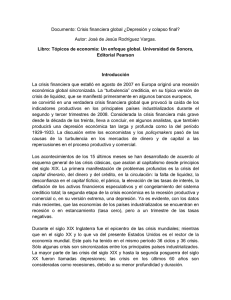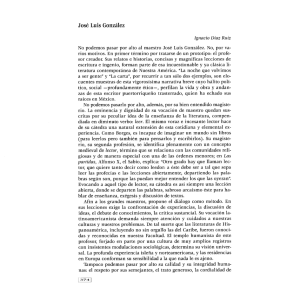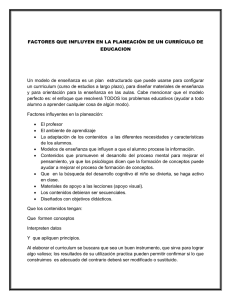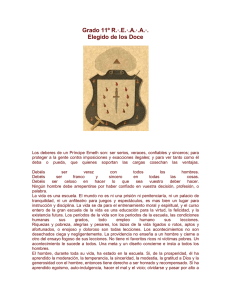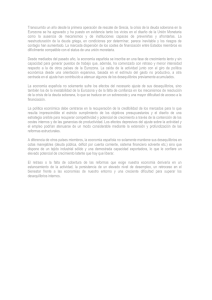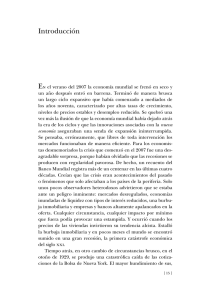Índice primera parte el pasado 1..¿Qué.pasó.en.1929?.El.año.que
Anuncio
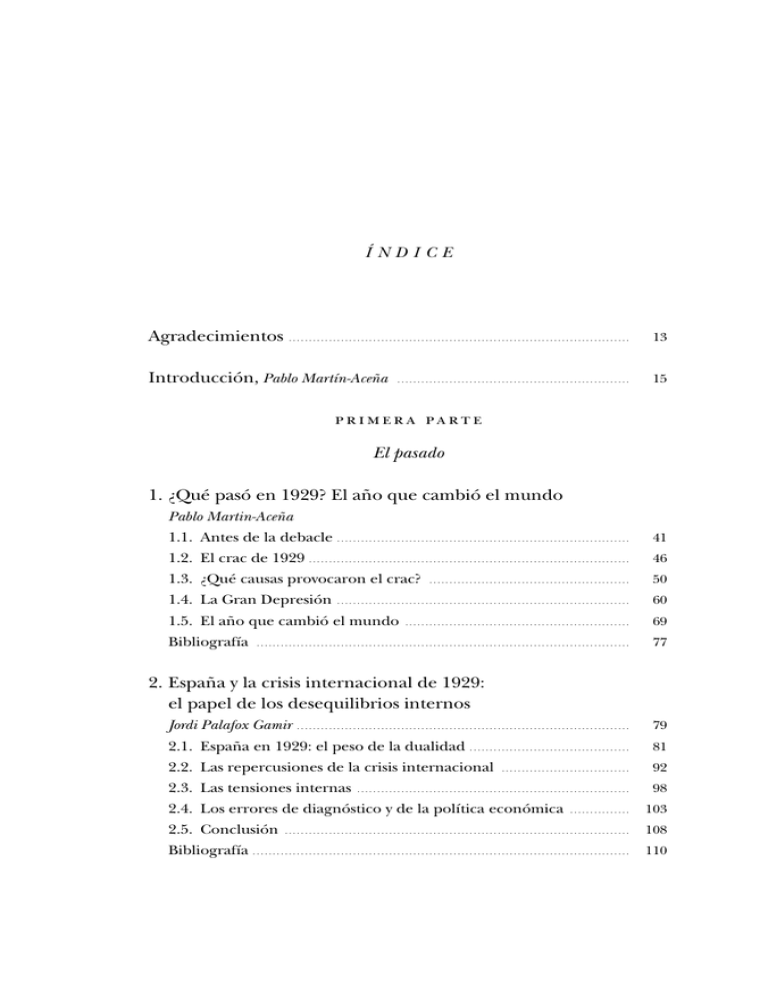
Índice Agradecimientos .. . . . . . . . . . . . . . . . . . . . . . . . . . . . . . . . . . . . . . . . . . . . . . . . . . . . . . . . . . . . . . . . . . . . . . . . . . . . . . . . . . . . . 13 Introducción, Pablo Martín-Aceña .. . . . . . . . . . . . . . . . . . . . . . . . . . . . . . . . . . . . . . . . . . . . . . . . . . . . . . . . . . 15 primera parte El pasado 1.¿Qué pasó en 1929? El año que cambió el mundo Pablo Martin-Aceña 1.1. Antes de la debacle . . . . . . . . . . . . . . . . . . . . . . . . . . . . . . . . . . . . . . . . . . . . . . . . . . . . . . . . . . . . . . . . . . . . . . . . . 41 1.2. El crac de 1929.. . . . . . . . . . . . . . . . . . . . . . . . . . . . . . . . . . . . . . . . . . . . . . . . . . . . . . . . . . . . . . . . . . . . . . . . . . . . . . . . 46 1.3. ¿Qué causas provocaron el crac? . . . . . . . . . . . . . . . . . . . . . . . . . . . . . . . . . . . . . . . . . . . . . . . . . . . 50 1.4. La Gran Depresión.. . . . . . . . . . . . . . . . . . . . . . . . . . . . . . . . . . . . . . . . . . . . . . . . . . . . . . . . . . . . . . . . . . . . . . . . . 60 1.5. El año que cambió el mundo. . . . . . . . . . . . . . . . . . . . . . . . . . . . . . . . . . . . . . . . . . . . . . . . . . . . . . . . . 69 Bibliografía . . . . . . . . . . . . . . . . . . . . . . . . . . . . . . . . . . . . . . . . . . . . . . . . . . . . . . . . . . . . . . . . . . . . . . . . . . . . . . . . . . . . . . . . . . . . . . 77 2.España y la crisis internacional de 1929: . el papel de los desequilibrios internos Jordi Palafox Gamir . . . . . . . . . . . . . . . . . . . . . . . . . . . . . . . . . . . . . . . . . . . . . . . . . . . . . . . . . . . . . . . . . . . . . . . . . . . . . . . . . . . 79 2.1. España en 1929: el peso de la dualidad . . . . . . . . . . . . . . . . . . . . . . . . . . . . . . . . . . . . . . . . 81 2.2. Las repercusiones de la crisis internacional . . . . . . . . . . . . . . . . . . . . . . . . . . . . . . . . 92 2.3. Las tensiones internas.. . . . . . . . . . . . . . . . . . . . . . . . . . . . . . . . . . . . . . . . . . . . . . . . . . . . . . . . . . . . . . . . . . . . 98 2.4. Los errores de diagnóstico y de la política económica .. . . . . . . . . . . . . . . 103 2.5. Conclusión. . . . . . . . . . . . . . . . . . . . . . . . . . . . . . . . . . . . . . . . . . . . . . . . . . . . . . . . . . . . . . . . . . . . . . . . . . . . . . . . . . . . . . . 108 Bibliografía.. . . . . . . . . . . . . . . . . . . . . . . . . . . . . . . . . . . . . . . . . . . . . . . . . . . . . . . . . . . . . . . . . . . . . . . . . . . . . . . . . . . . . . . . . . . . . . 110 3.La Gran Depresión y la Gran Recesión: . ¿qué hemos aprendido? Michael D. Bordo y Harold James 3.1. La analogía con la Gran Depresión . . . . . . . . . . . . . . . . . . . . . . . . . . . . . . . . . . . . . . . . . . . . . . 113 3.2. La política monetaria .. . . . . . . . . . . . . . . . . . . . . . . . . . . . . . . . . . . . . . . . . . . . . . . . . . . . . . . . . . . . . . . . . . . . . 114 3.2.1. La recesión de 1937-1938 .................................................. 118 3.2.2. La trampa de la liquidez. . . . . . . . . . . . . . . . . . . . . . . . . . . . . . . . . . . . . . . . . . . . . . . . . . . . . 120 3.2.3. Lecciones para el presente. . . . . . . . . . . . . . . . . . . . . . . . . . . . . . . . . . . . . . . . . . . . . . . . . 120 3.3. El sector financiero . . . . . . . . . . . . . . . . . . . . . . . . . . . . . . . . . . . . . . . . . . . . . . . . . . . . . . . . . . . . . . . . . . . . . . . . 122 3.3.1. Lecciones para el momento actual . . . . . . . . . . . . . . . . . . . . . . . . . . . . . . . . . . . . 124 3.4. Los desequilibrios globales .. . . . . . . . . . . . . . . . . . . . . . . . . . . . . . . . . . . . . . . . . . . . . . . . . . . . . . . . . . . . 129 3.5. Lecciones del fracaso de la cooperación internacional . . . . . . . . . . . . . . 131 3.5.1. Por qué las lecciones son desagradables .. . . . . . . . . . . . . . . . . . . . . . . . . . 137 Bibliografía . . . . . . . . . . . . . . . . . . . . . . . . . . . . . . . . . . . . . . . . . . . . . . . . . . . . . . . . . . . . . . . . . . . . . . . . . . . . . . . . . . . . . . . . . . . . . . 138 segunda parte El presente 4.Desequilibrios macrofinancieros y crisis económica Javier Andrés Domingo y Óscar Arce Hortigüela 4.1. Introducción .. . . . . . . . . . . . . . . . . . . . . . . . . . . . . . . . . . . . . . . . . . . . . . . . . . . . . . . . . . . . . . . . . . . . . . . . . . . . . . . . . . 143 4.2. El entorno precrisis: estabilidad . macroeconómica y desequilibrios financieros .. . . . . . . . . . . . . . . . . . . . . . . . . . . . 145 4.2.1. La Gran Moderación .. . . . . . . . . . . . . . . . . . . . . . . . . . . . . . . . . . . . . . . . . . . . . . . . . . . . . . . . . . 147 4.2.2. La acumulación de desequilibrios globales .. . . . . . . . . . . . . . . . . . . . . 154 4.3. Innovación financiera y desequilibrios globales . . . . . . . . . . . . . . . . . . . . . . . . . . 161 4.3.1. El incremento en la demanda de activos seguros .. . . . . . . . . . . 161 4.4. Las vulnerabilidades del sistema global . de transferencia de riesgos de crédito .. . . . . . . . . . . . . . . . . . . . . . . . . . . . . . . . . . . . . . . . . 169 4.4.1. Los fallos en los mercados de . transferencia de riesgo de crédito . . . . . . . . . . . . . . . . . . . . . . . . . . . . . . . . . . . . . 171 4.4.2. La infravaloración del riesgo sistémico .. . . . . . . . . . . . . . . . . . . . . . . . . . . . 178 4.5. Conclusiones .. . . . . . . . . . . . . . . . . . . . . . . . . . . . . . . . . . . . . . . . . . . . . . . . . . . . . . . . . . . . . . . . . . . . . . . . . . . . . . . . . . 181 Bibliografía . . . . . . . . . . . . . . . . . . . . . . . . . . . . . . . . . . . . . . . . . . . . . . . . . . . . . . . . . . . . . . . . . . . . . . . . . . . . . . . . . . . . . . . . . . . . . . 182 5. La crisis financiera mundial: lecciones y retos José Manuel González-Páramo 5.1. Introducción .. . . . . . . . . . . . . . . . . . . . . . . . . . . . . . . . . . . . . . . . . . . . . . . . . . . . . . . . . . . . . . . . . . . . . . . . . . . . . . . . . . 187 5.2. Comparación entre la crisis actual y la Gran Depresión .. . . . . . . . . . . . 188 5.2.1. El coste macroeconómico .. . . . . . . . . . . . . . . . . . . . . . . . . . . . . . . . . . . . . . . . . . . . . . . . . . 188 5.2.2. Diferencias en las causas, las dinámicas . y las medidas adoptadas . . . . . . . . . . . . . . . . . . . . . . . . . . . . . . . . . . . . . . . . . . . . . . . . . . . . . 194 5.3. Intervenciones de las autoridades públicas . . . . . . . . . . . . . . . . . . . . . . . . . . . . . . . . . . 196 5.3.1. Las medidas de gestión de la liquidez del Eurosistema. . . 197 5.3.2. Orientación de la política monetaria del Eurosistema .. . . 211 5.3.3. Política fiscal .. . . . . . . . . . . . . . . . . . . . . . . . . . . . . . . . . . . . . . . . . . . . . . . . . . . . . . . . . . . . . . . . . . . . . . . 212 5.3.4. Medidas de respaldo del sector financiero .. . . . . . . . . . . . . . . . . . . . . . 214 5.4. Lecciones de la crisis . . . . . . . . . . . . . . . . . . . . . . . . . . . . . . . . . . . . . . . . . . . . . . . . . . . . . . . . . . . . . . . . . . . . . . 216 5.4.1. Lecciones que se pueden extraer . de lo que ha resultado efectivo .. . . . . . . . . . . . . . . . . . . . . . . . . . . . . . . . . . . . . . . . . 217 5.4.2. Lecciones que se pueden extraer de lo que . no ha funcionado bien y es necesario reformar .. . . . . . . . . . . . . . 219 5.5. Comentarios finales .. . . . . . . . . . . . . . . . . . . . . . . . . . . . . . . . . . . . . . . . . . . . . . . . . . . . . . . . . . . . . . . . . . . . . . . 226 Bibliografía .. . . . . . . . . . . . . . . . . . . . . . . . . . . . . . . . . . . . . . . . . . . . . . . . . . . . . . . . . . . . . . . . . . . . . . . . . . . . . . . . . . . . . . . . . . . . . 229 6. Orígenes y alcance de la crisis financiera Vincent R. Reinhart 6.1. Introducción . . . . . . . . . . . . . . . . . . . . . . . . . . . . . . . . . . . . . . . . . . . . . . . . . . . . . . . . . . . . . . . . . . . . . . . . . . . . . . . . . . . 231 6.2. Los orígenes de la recesión.. . . . . . . . . . . . . . . . . . . . . . . . . . . . . . . . . . . . . . . . . . . . . . . . . . . . . . . . . . . . 233 6.3. Amplificación en los mercados financieros. . . . . . . . . . . . . . . . . . . . . . . . . . . . . . . . . . 236 6.4. El alcance de la crisis .. . . . . . . . . . . . . . . . . . . . . . . . . . . . . . . . . . . . . . . . . . . . . . . . . . . . . . . . . . . . . . . . . . . . . 239 6.5 La contribución internacional . a los excesos de los Estados Unidos.. . . . . . . . . . . . . . . . . . . . . . . . . . . . . . . . . . . . . . . . . . . . . . 242 6.6. Las medidas de política económica . . . . . . . . . . . . . . . . . . . . . . . . . . . . . . . . . . . . . . . . . . . . . . 246 6.7. Conclusión . . . . . . . . . . . . . . . . . . . . . . . . . . . . . . . . . . . . . . . . . . . . . . . . . . . . . . . . . . . . . . . . . . . . . . . . . . . . . . . . . . . . . . 251 Bibliografía . . . . . . . . . . . . . . . . . . . . . . . . . . . . . . . . . . . . . . . . . . . . . . . . . . . . . . . . . . . . . . . . . . . . . . . . . . . . . . . . . . . . . . . . . . . . . . 252 7. Volatilidad y crisis: tres lecciones para países en desarrollo Norman Loayza . . . . . . . . . . . . . . . . . . . . . . . . . . . . . . . . . . . . . . . . . . . . . . . . . . . . . . . . . . . . . . . . . . . . . . . . . . . . . . . . . . . . . . . . . 255 7.1. Las crisis autoinfligidas son las peores . (o habría que dejar de culpar a la globalización). . . . . . . . . . . . . . . . . . . . . . . . 258 7.2. Los seguros gratuitos a actividades de riesgo son rara . vez sostenibles, siempre distorsionantes y usualmente . catastróficos (o no hay que prometer . lo que no se puede cumplir) .. . . . . . . . . . . . . . . . . . . . . . . . . . . . . . . . . . . . . . . . . . . . . . . . . . . . . . . . . 262 7.3. Son las fluctuaciones grandes, no la volatilidad normal, . lo que daña la economía (o es mejor soportar . temblores frecuentes que un gran terremoto). . . . . . . . . . . . . . . . . . . . . . . . . . . . . 266 7.4. Conclusiones . . . . . . . . . . . . . . . . . . . . . . . . . . . . . . . . . . . . . . . . . . . . . . . . . . . . . . . . . . . . . . . . . . . . . . . . . . . . . . . . . . . 271 Bibliografía . . . . . . . . . . . . . . . . . . . . . . . . . . . . . . . . . . . . . . . . . . . . . . . . . . . . . . . . . . . . . . . . . . . . . . . . . . . . . . . . . . . . . . . . . . . . . . 272 8.La crisis en España: la herencia . de un crecimiento desequilibrado Francisco Pérez García .. . . . . . . . . . . . . . . . . . . . . . . . . . . . . . . . . . . . . . . . . . . . . . . . . . . . . . . . . . . . . . . . . . . . . . . . . . . . . . . 273 8.1. Crecimiento y crisis: rasgos generales . . . . . . . . . . . . . . . . . . . . . . . . . . . . . . . . . . . . . . . . . . . 274 8.2. El enigma de la productividad .. . . . . . . . . . . . . . . . . . . . . . . . . . . . . . . . . . . . . . . . . . . . . . . . . . . . . . 280 8.3. Otros desequilibrios gestados durante el crecimiento . . . . . . . . . . . . . . . . 291 8.4. Las dificultades durante la crisis .. . . . . . . . . . . . . . . . . . . . . . . . . . . . . . . . . . . . . . . . . . . . . . . . . . . 294 8.5. Perspectivas y palancas de recuperación.. . . . . . . . . . . . . . . . . . . . . . . . . . . . . . . . . . . . . . 300 Bibliografía . . . . . . . . . . . . . . . . . . . . . . . . . . . . . . . . . . . . . . . . . . . . . . . . . . . . . . . . . . . . . . . . . . . . . . . . . . . . . . . . . . . . . . . . . . . . . . 306 9.La banca española entre la financiación . del crecimiento y la crisis financiera internacional Joaquín Maudos Villarroya 9.1. Introducción .. . . . . . . . . . . . . . . . . . . . . . . . . . . . . . . . . . . . . . . . . . . . . . . . . . . . . . . . . . . . . . . . . . . . . . . . . . . . . . . . . . . 309 9.2. La financiación del crecimiento económico .. . . . . . . . . . . . . . . . . . . . . . . . . . . . . . . 311 9.3. Los retos del sector bancario español . . . . . . . . . . . . . . . . . . . . . . . . . . . . . . . . . . . . . . . . . . . 317 9.3.1. Elevada concentración del riesgo . en el mercado inmobiliario. . . . . . . . . . . . . . . . . . . . . . . . . . . . . . . . . . . . . . . . . . . . . . . . 318 9.3.2. Aumento en la tasa de morosidad.. . . . . . . . . . . . . . . . . . . . . . . . . . . . . . . . . . . . . 319 9.3.3. Mejora de las condiciones . de acceso a la financiación bancaria.. . . . . . . . . . . . . . . . . . . . . . . . . . . . . . . . . 321 9.3.4. Restricciones de liquidez en los mercados mayoristas .. . . . 323 9.3.5. Reducción de los márgenes bancarios.. . . . . . . . . . . . . . . . . . . . . . . . . . . . . . 324 9.3.6. Exceso de capacidad instalada . . . . . . . . . . . . . . . . . . . . . . . . . . . . . . . . . . . . . . . . . . . 327 9.3.7. Cambios en la regulación y mayores . exigencias de recursos propios.. . . . . . . . . . . . . . . . . . . . . . . . . . . . . . . . . . . . . . . . . . 329 9.4. Las respuestas a la crisis del sector bancario español . . . . . . . . . . . . . . . . . . 331 9.4.1. El Fondo de Reestructuración Ordenada Bancaria .. . . . . . . . 332 9.4.2. La reforma de las cajas de ahorros.. . . . . . . . . . . . . . . . . . . . . . . . . . . . . . . . . . . . 333 9.4.3. La publicación de las pruebas de resistencia. . . . . . . . . . . . . . . . . . . . 333 9.4.4. Cambios en materia de provisiones .. . . . . . . . . . . . . . . . . . . . . . . . . . . . . . . . . . 334 9.5. Conclusiones.. . . . . . . . . . . . . . . . . . . . . . . . . . . . . . . . . . . . . . . . . . . . . . . . . . . . . . . . . . . . . . . . . . . . . . . . . . . . . . . . . . . 335 Bibliografía . . . . . . . . . . . . . . . . . . . . . . . . . . . . . . . . . . . . . . . . . . . . . . . . . . . . . . . . . . . . . . . . . . . . . . . . . . . . . . . . . . . . . . . . . . . . . . 339 10.Claves para la salida de la crisis en España José Luis Malo de Molina .. . . . . . . . . . . . . . . . . . . . . . . . . . . . . . . . . . . . . . . . . . . . . . . . . . . . . . . . . . . . . . . . . . . . . . . 341 10.1. El impacto de la crisis financiera internacional . . . . . . . . . . . . . . . . . . . . . . 350 10.2. La Gran Recesión en España . . . . . . . . . . . . . . . . . . . . . . . . . . . . . . . . . . . . . . . . . . . . . . . . . . . . 351 10.3. La reestructuración del sistema bancario y la crisis fiscal . . . . . . . 355 Bibliografía .. . . . . . . . . . . . . . . . . . . . . . . . . . . . . . . . . . . . . . . . . . . . . . . . . . . . . . . . . . . . . . . . . . . . . . . . . . . . . . . . . . . . . . . . . . . 365 Índice de cuadros.. . . . . . . . . . . . . . . . . . . . . . . . . . . . . . . . . . . . . . . . . . . . . . . . . . . . . . . . . . . . . . . . . . . . . . . . . . . . . . . . . . . 367 Índice de esquemas.. . . . . . . . . . . . . . . . . . . . . . . . . . . . . . . . . . . . . . . . . . . . . . . . . . . . . . . . . . . . . . . . . . . . . . . . . . . . . . . 369 Índice de gráficos. . . . . . . . . . . . . . . . . . . . . . . . . . . . . . . . . . . . . . . . . . . . . . . . . . . . . . . . . . . . . . . . . . . . . . . . . . . . . . . . . . . . 371 Índice alfabético. . . . . . . . . . . . . . . . . . . . . . . . . . . . . . . . . . . . . . . . . . . . . . . . . . . . . . . . . . . . . . . . . . . . . . . . . . . . . . . . . . . . . . 375 Nota sobre los autores.. . . . . . . . . . . . . . . . . . . . . . . . . . . . . . . . . . . . . . . . . . . . . . . . . . . . . . . . . . . . . . . . . . . . . . . . . . 385
